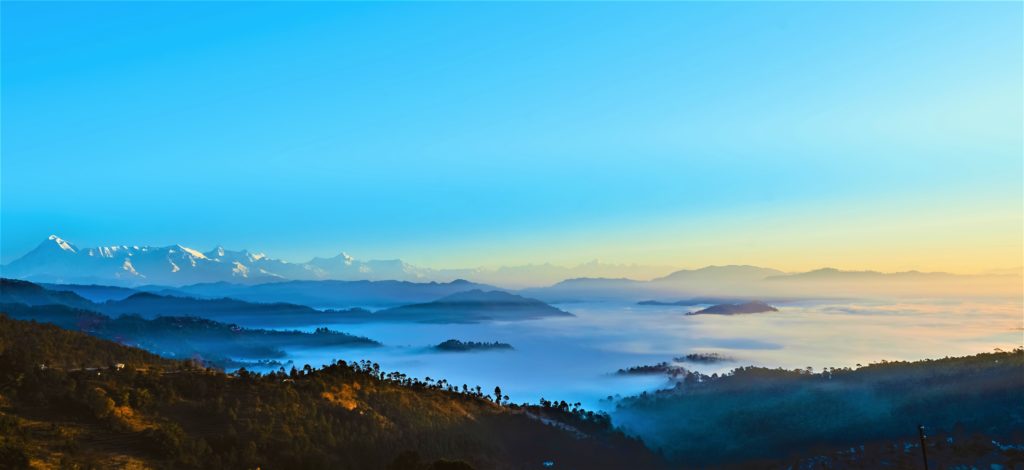
Shitlakhet and the villages surrounding it (including Salla Rautela) makes for a very interesting cluster that seems to have had a cosmopolitan history – having proximity to the significant town of Almora.
Shitlakhet is located 30km from both Ranikhet and Almora. Historically, it has been known as the market and gateway to the temple of Syahi Devi – attracting pilgrims locally on special occasions. Shitlakhet is known such because of the oak forests near it which keep it close or “Sitla”.
Economy of Shitlakhet
The villages around Shitlakhet have had a primarily agrarian economy. However, with better opportunities in cities like Haldwani, Dehradun, and Delhi, few people tend to the large landholdings. Local and introduced monkeys also create havoc and dissuade the local population from following this lifestyle.
However, while many families have shops now, there are many who still grow the traditional crops including, Lai, Gadheri, Bhat, Gahat, Rajma, and Pumpkin, and gather chestnuts and walnuts. Immigrants from Nepal help in working on the crops or with village chores as may be necessary.
Historical Significance
Shitlakhet is a market village set up by Nardev Pathak in the early 20th century. Even today, most of the shops in the village are owned by the Pathaks. The village used to be a stop on the trek from Khairna to Karnaprayag en route Badrinath.
Being on a juncture between Almora and Ranikhet, the region witnesses its own set of historical tourists – Bhabariyas or shepherds who trek with their sheep from Joshimath to the plains of Ramnagar during the winter months in search of grass. They cover the route of 300km in a span of 2 months. On the way, they stay over at Shitlakhet, and you can spend winter mornings navigating through the maze of wool.
Shitlakhet and the mountains of Syahi Devi have also been hunting grounds for the British and old British trails are still used. The oak forests still hold a lot of water and the British pipelines that supplied water to the town of Almora from Syahi Devi (a distance of 30km) are still in service.
In the evening, while sipping your whisky, you’d see the lights of Almora in the distance. In the day, you’ll see the Kilmora tree from which the name Almora is derived. You will love seeing the busy markets of this 16th Century town. Almora has seen war and culture like most major cities in India have.
Exploring Shitlakhet
Shitlakhet is known for its natural beauty. Local residents fiercely protect this beauty. A plethora of wildlife live in the rich oak and pine forests of this region. The panoramic views of the Himalayas from various points on various hikes make for excellent visual memories. The temples dotting the landscape help give an insight into local myth, history and legend. Here’s more on the soundscape of Shitlakhet.
Languages spoken in Sitlakhet
People of the Sitlakhet valley speak English, Hindi and Kumaoni. Kumaoni language is one of the 325 recognized languages of India and this language is spoken by 2,360,000 people all over the world. This Kumaoni language has about twenty dialects; some of them are Kali Kumaon, North Eastern Kumaoni, South Eastern Kumaoni, Askoti of Askot, Danpuriya of Danpur, Kumaiyya, Pashchimi, Sirali of Sirakot and many more. Most people who understand the Kumaoni language can understand Hindi language also.
Festivals of Shitlakhet
Places near Shitlakhet
The best time to visit Shitlakhet
Shitlakhet is a destination for all seasons. Different times of the year bring out different facets of the property.
Winter
Nayalap is great during the winter. The tents are warm enough and equipped with heaters during that time. The days are sunny and you should be able to see the beautiful Kuman Himalayas range through the day. Time to visit: Nov-Feb
Spring
The Kumaoni Holi is one worth traveling for – especially for women. Every day leading up to Holi, village women visit different houses. The day is filled with singing and dancing to welcome spring. Time to visit: Mar
Monsoon
Take it slow. Finish your book. Or your series. Pick up an umbrella and walk through the clouds. Go on a hike and cross gushing streams and small waterfalls. See new types of mushrooms, lush green valleys, and possibly the Himalayas at night. Time to visit: Jul-Sep
Autumn
UNESCO has listed the Almora Ramlila on its Representative List of the Intangible Cultural Heritage of Humanity. Over the days, processions are taken out throughout the town, and actors of repute dress and act to tell you the lore of the great epic. Time to visit: Oct
